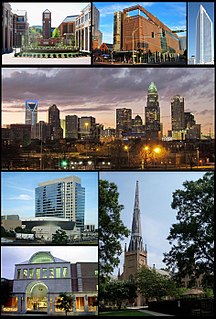
Charlotte is the most populous city in the U.S. state of North Carolina. Located in the Piedmont region, it is the county seat of Mecklenburg County. The population was 874,579 as of the 2020 census, making it the 16th-most populous city in the U.S., the second-most populous city in the Southeast behind Jacksonville, Florida, and seventh-largest city in the Southern United States. The city is the cultural, economic, and transportation center of the Charlotte metropolitan area, whose population ranks 23rd in the U.S., and had a population of 2,660,329, in 2020. The Charlotte metropolitan area is part of a sixteen-county market region or combined statistical area with a 2020 census-estimated population of 2,846,550.

Mecklenburg County is a county located in the southwestern region of the state of North Carolina, in the United States. As of the 2010 census, the population was 919,618. It increased to 1,110,356 as of the 2019 estimate, making it the second-most populous county in North Carolina and the first county in the Carolinas to surpass one million in population. Its county seat is Charlotte, and is the state's largest city.

Cabarrus County is a county located in the south-central part of the U.S. state of North Carolina. As of the 2010 census, the population was 178,011. The county seat is Concord, which was incorporated in 1803.

Horne Creek Farm is a historical farm near Pinnacle, Surry County, North Carolina. The farm is a North Carolina State Historic Site that belongs to the North Carolina Department of Natural and Cultural Resources, and it is operated to depict farm life in the northwest Piedmont area c. 1900. The historic site includes the late 19th century Hauser Farmhouse, which has been furnished to reflect the 1900-1910 era, along with other supporting structures. The farm raised animal breeds that were common in the early 20th century. The site also includes the Southern Heritage Apple Orchard, which preserves about 800 trees of about 400 heritage apple varieties. A visitor center includes exhibits, a gift shop and offices.

Myers Park is a neighborhood and historic district in Charlotte, North Carolina, United States.

Horton Grove was an area of houses for enslaved African-Americans at the 30,000-acre (120 km2) Bennehan-Cameron plantation complex, which included Stagville Plantation in the northeastern part of Durham County, North Carolina. The slaves who lived at Horton Grove were held by the influential Bennehan and Cameron families. In 1860, 900 total slaves were held on the complex. The several structures still standing at Horton Grove are the only two-story slave residences remaining in North Carolina.

Mountain Island Lake is a lake northwest of Charlotte, North Carolina created in 1924 to coincide with the building of Mountain Island Hydroelectric Station. It is named after the mountain which appears as an island in the lake, and the surrounding area is identified by the lake's name. The shape of the lake follows the meander of the Catawba River's course, dammed near the Mount Holly Wastewater Plant. Full pond elevation is approximately 647.5 feet (197 m). The lake has around 3,281 acres (13 km2) of surface area and 61 miles (98 km) of shoreline.

Dilworth is a neighborhood of Charlotte, Mecklenburg County, North Carolina, United States. The neighborhood was Charlotte's first streetcar suburb and was established by Edward Dilworth Latta in the 1890s on 250 acres (1 km²) southwest of the original city limits. It included the Joseph Forsyth Johnson designed Latta Park. Planned largely with a grid pattern similar to the city's original four wards, Dilworth was initially designated the Eighth Ward.

The Hoyle Historic Homestead, also known as Hoyle Family Homestead, Peter Hoyle House, and Pieter Hieyl Homeplace, is a mid- to late-18th century two-story house in Gaston County, North Carolina, with notable German-American construction features, the main block of which reflects two, and possibly three, phases, but the exact construction dates have not been determined. A major renovation, c. 1810, added a late Georgian and Federal finish, as well as front and rear shed porches. A brick well house and a frame smokehouse, both east of the house, date from the 19th century. Almost nine acres, with several large walnut trees, surround the buildings.

Jacob W. Holt was an American carpenter and builder-architect in Warrenton, North Carolina. Some twenty or more buildings are known to have been built by him or are attributed to him and his workshop by local tradition or their distinctive style. Some of his work includes among others Long Grass Plantation, Eureka near Baskerville, Virginia; Shadow Lawn at Chase City, Virginia; buildings at Peace College; Vine Hill near Centerville, North Carolina; Dr. Samuel Perry House near Gupton, North Carolina; the Archibald Taylor House near Wood, North Carolina; Salem Methodist Church near Huntsboro, North Carolina; Hebron Methodist Church in Warren County, North Carolina; and the John Watson House and possibly the house known as Annefield in Charlotte County, Virginia and Belvidere and Pool Rock Plantation near Williamsboro, North Carolina. He may have also built the Forestville Baptist Church at Forestville, North Carolina.

Annefield is a historic plantation house located at Saxe, Charlotte County, Virginia. It was constructed in 1858, and is a well-preserved example of the Italianate style villas being constructed during the antebellum period in northern North Carolina and Southern Virginia by master builder Jacob W. Holt (1811–1880). Annefield is one of only two known plantation houses in Charlotte County attributed to Holt, a Virginia-born carpenter, builder, and contractor who moved to Warrenton, North Carolina, and established one of North Carolina's largest antebellum building firms. Architectural historian Catherine W. Bishir notes: “Drawing upon popular architectural books, Holt developed a distinctive style that encompassed Greek Revival and Italianate features adapted to local preferences and the capabilities of his workshop. In addition to the more than twenty buildings documented as his work, stylistic evidence and family traditions also attribute as many as seventy more to Holt and his shop.”
Reedy Creek Park is a 125 acre urban park at 2900 Rocky River Road in the Newell section of Charlotte, North Carolina. Adjacent to the park is a 737 acre nature preserve.

The Latta Arcade is an indoor shopping arcade located at 320 S. Tryon St. in Charlotte, Mecklenburg County, North Carolina. It was built in 1914 to include a two floor atrium with stores and restaurants. There is a glass skylight over the atrium, which was originally used to allow natural light for grading cotton. It was designed by architect William H. Peeps.
Cedar Grove Plantation is a historic house located in Huntersville, North Carolina. It was the home of James G. Torrance, a planter living in central Mecklenburg County. It is currently privately owned, and is closed to the public. The plantation was named for its location in the midst of a grove of Cedar trees.

The Espy Watts Brawley House, also known as the Brawley House, is a historic home located at Mooresville, Iredell County, North Carolina. It was built in 1904, and is a large 2+1⁄2-story, transitional Queen Anne / Colonial Revival style frame dwelling. It has a two-story side wing with a two-story, three-sided bay; truncated slate hipped roof; and one-story wraparound porch with porte-cochère. Also on the property are two contributing outbuildings.

China Grove is a historic plantation house located near Oriental, North Carolina. Built sometime in the late-18th century to early-19th century, the Federal style home was named for a row of chinaberry trees that once led to its entrance. China Grove is one of North Carolina's most dramatically sited plantation homes, overlooking the Neuse River at one of its widest points, near the mouth of Dawson's Creek. The house was added to the National Register of Historic Places (NRHP) in 1973.

The 1774 Alexander Rock House in Charlotte, North Carolina is the oldest house in Mecklenburg County, North Carolina and was named to the National Register of Historic Places in 1970. Originally built by the Alexander Family who finished construction in 1774, the Rock House and its various outbuildings have had many owners over the years with The Charlotte Museum of History being its steward today.

Potts Plantation is a historic plantation complex and national historic district located near Cornelius, Mecklenburg County, North Carolina. The district encompasses 11 contributing buildings, 12 contributing sites, and 4 contributing structures in rural Mecklenburg County. The plantation seat was built in 1811, and consists of a two-story, three bay, weatherboarded log house on a low brick foundation with flanking one-story wings added in 1947. The house has Federal, Late Victorian, and Colonial Revival style design elements. Associated with the plantation seat are the contributing smokehouse, dependency, poultry house, double-pen log barn work area, and corn crib. Other notable contributing resources are the Slave Cemetery, five tenant complexes, the Smith Cottage Complex, Smith Cottage, and Potts Cemetery (1946). The Potts Plantation has been the property of the Potts family since 1753.

Textile Mill Supply Company Building is a historic factory building located at Charlotte, Mecklenburg County, North Carolina. It was designed by Lockwood, Greene & Co. and built in 1922. It is a three-story, ten-bay wide by-five-bay deep, red brick structure with a full basement. It has large rectangular windows and pine post-and-beam interior framing. The building housed the Textile Mill Supply Company that sold and distributed supplies essential to the operations of textile mills in the Piedmont sections of the Carolinas.
Lake O'Woods, also known as the Edward and Rebecca Pitchford Davis House, is a historic plantation house located near Inez, Warren County, North Carolina. The main house was built by Albert Gamaliel Jones in 1852. It is a two-story, three bay by two bay, Greek Revival style frame dwelling. It has a shallow, overhanging hipped roof and entrance porch with fluted columns. Also on the property are the contributing earlier house or kitchen ; four hole outhouse; a log chicken house; an early smokehouse and a later one of logs; a mounted farm bell; a well; and a collection of barns and stable.





















